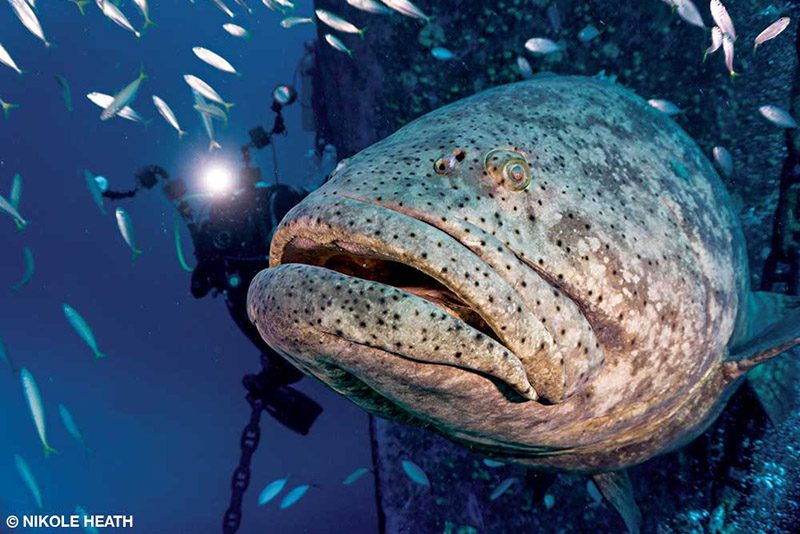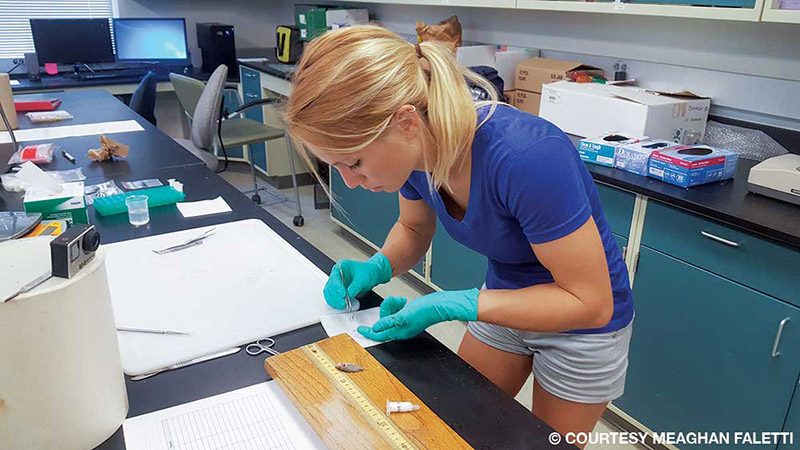As scuba divers, life beneath the waves is peaceful as we move weightlessly through the water column in relative quiet aside from the air bubbling from our regulators, the whirl of distant boat propellers and the snap, crackle and pop of parrotfish munching on the reef. From this tranquil vantage point near the top of the food chain, it is easy to forget that this is a fish-eat-fish world for everything else swimming around. And one group of finned friends is just about every predator’s dish du jour.
Forage fish are small, schooling fish such as mullet, pinfish, anchovies and menhaden that feed on plankton and are eaten by predators of all shapes and sizes. This unexclusive forage fish diner’s club includes bottlenose dolphins, grouper, ospreys and sharks. Predators thrive with these bite-sized morsels in abundance.
People also pursue forage fish: By volume, more menhaden than any other species are caught on the U.S. East Coast. Large “reduction” fisheries around the world remove forage fish from the marine ecosystems and process them into ingredients for products such as aquaculture feed, dietary supplements and cosmetics. Think about that the next time you order a farmed salmon or pop an omega-3 capsule.

In Florida, forage fish represent about 30 percent of the commercial catch. Some of these fish are destined for human consumption in the form of cured mullet roe, known as bottarga, and smoked mullet, and some are sold as bait for recreational and commercial fishermen. The real moneymaker for Florida, however, is the billions in economic impact from fishing and recreation that is made possible by those forage fish left in the water to feed valuable predators. This is no surprise to the Florida Fish and Wildlife Conservation Commission, which adopted a resolution in 2015 highlighting the agency’s commitment to forage fish.
With so much riding on these little fish, one would think scientists have by now poked and prodded all their secrets out of them. Think again. Wildlife and big fish that people like to catch have historically received most of the attention, while forage fish, with a few exceptions, have largely remained underappreciated and off the radar. Efforts are underway to change that, however.
The Florida Forage Fish Research Program (FFFRP) is a public-private partnership between the Florida Fish and Wildlife Research Institute (FWRI), leading educational institutions and the Florida Forage Fish Coalition. Now in its second year, the FFFRP is like a scientific matchmaker: FWRI has a large amount of data that could help answer important research questions about forage fish but lacks the resources to thoroughly analyze the information, and Florida’s academic institutions are home to many bright, young graduate students who would love the opportunity to work with this data.

To tackle this dilemma, FFFRP awards up to three fellowships per year to this next generation of fishery scientists. Fellowships provide students with expert guidance and the funding necessary to investigate links between forage species and their dependent predators, their relationships to essential fish habitats and their responses to natural disturbances such as cold-weather kills, harmful algal blooms, droughts and hurricanes. The results of these investigations are then submitted for peer review so that they may inform future fishery management decisions and continue to build upon growing awareness and action for forage fish conservation.
In early 2017 the program awarded the first two fellowships to Meaghan Faletti of the University of South Florida and Ed Camp of the University of Florida. Using cutting-edge techniques, Faletti examined chemical tracers from the eye lens of pinfish to determine important information about where they were spawned and how their populations fluctuate over time in four Gulf Coast estuaries. Her findings suggest that pinfish migrate from inshore seagrass habitats to distinct offshore regions to spawn. Faletti also learned from examining nearly two decades of FWRI data that the presence of healthy seagrass, which is a critical habitat and food resource for pinfish, is positively related to increased pinfish abundance.
Camp focused his research on redfish, one of Florida’s most popular recreational fish species. Providing the first diet study of juvenile and slot-size redfish in Florida, Camp found that pinfish make up a whopping 45 percent of young redfish diets. Combine this research with Faletti’s findings on pinfish’s relationship to seagrass, and it becomes apparent that as seagrass continues to disappear from our estuaries, so too could pinfish and potentially their predators.

We’re submitting these results for publication in peer-reviewed journals. In 2018 FFFRP awarded two new fellowships that will yield further insights into forage fish biodiversity and community structure on Florida’s Gulf Coast, as well as how these communities have changed in the increasingly beleaguered Indian River Lagoon on Florida’s east coast.
Keeping forage fish on the menu and abundant for Florida’s predators starts with learning more about them. For more information about these fish or to contribute to FFFRP, please visit floridaforagefish.org.
Read the resolution at floridaforagefish.org/foragefish/Content/forage-fish-resolution.pdf.
© Alert Diver — Q1 2019